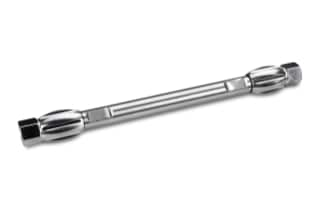
|
Chemistry |
C18 |
|
Separation Mode |
Reversed Phase |
|
Particle Substrate |
Silica |
|
pH Range Min |
2 pH |
|
pH Range Max |
8 pH |
|
Maximum Pressure |
6000 psi (415 Bar) |
|
Endcapped |
Yes |
|
Bonding Technology |
T3 |
|
Silanol Activity |
Medium |
|
Particle Shape |
Spherical |
|
Particle Size |
3 µm |
|
Endfitting Type |
Waters |
|
Pore Size |
100 Å |
|
Format |
Column |
|
Surface Area |
330 |
|
System |
HPLC |
|
USP Classification |
L1 |
|
Inner Diameter |
3 mm |
|
Length |
100 mm |
|
Carbon Load |
14 % |
|
UNSPSC |
41115709 |
|
Brand |
Atlantis |
|
Product Type |
Columns |
|
Units per Package |
1 pk |
Atlantis T3 Column, 100Å, 3 µm, 3 mm X 100 mm, 1/pk
With the development of T3 bonding, the performance of Atlantis T3 HPLC Columns is unparalleled. T3 bonding utilizes a trifunctional C18 alkyl phase bonded at ligand density that promotes polar compound retention and mobile phase compatibility. Because of its unique composition, the T3 end-capping is much more efficient than traditional trimethyl silane (TMS) end-capping. Combining the bonding and end-capping features of the Atlantis T3 Column, you will get superior polar compound retention and aqueous compatibility in your sample preparation, along with enhanced column performance, improved lifetime, peak shape, and stability.
Since Atlantis T3 HPLC Column relies on T3 bonding, same as the ACQUITY UPLC HSS (High Strength Silica) T3 column, the HPLC methods can be transferred easily to UPLC methods. Given that the HSS and Atlantis particles are different substrates, some method modification and optimization may be needed to ensure transferability.
The Atlantis T3 Columns are uniquely designed to offer extended column lifetimes under low pH conditions, but also providing superior and unparalleled polar compound retention and peak shape. Typically column lifetimes get shortened due to dissolution of the silica particle substrates by the high mobile pH phase. However, the T3 bonding protects the silica substrate from dissolution and thereby effectively extending the columns’ lifetime.
You can increase your productivity with the ideal lab equipment. To learn more about the variations of the same product, such as the Atlantis T3 Column, or to find additional products that work with it, check out our website and shop for lab equipment; you can browse through our inventory and ensure your laboratory equipment needs are met.
Also may like Atlantis Silica T3 VanGuard Cartridge, 100Å, 3 µm, 2.1 mm X 5 mm, 3/pk, which can be used to extend the analytical column's lifetime and performance by removing particulate contamination from the mobile phase stream. The Atlantis T3 VanGuard cartridge is optimized to protect all 2.1 mm and 3.0 mm ID Atlantis T3 analytical columns containing 3 µm sorbent particles.
What Is Mass Spectrometry (MS)?
The principle of MS (Mass Spectrometry) is to generate ions from organic or inorganic compounds by using any suitable methods and to separate the ions as per their mass-to-charge ratio so they can be quantified and qualified as per their concentration and mass-to-charge ratio.
What Is The Importance Of Resolution In Chromatography?
Optimizing separations in chromatography can be achieved through the utilization of resolution measurements, which are influenced by two intrinsic properties of the chromatographic process: peak width and retention time. Since resolution is directly impacted by these factors, it serves as a valuable parameter for assessing and fine-tuning the efficiency of separations. By manipulating peak width and retention time, scientists can strategically enhance resolution and ultimately improve the accuracy and quality of chromatographic analyses.